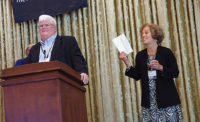Rewarding key employees with incentive plans

If someone said you could increase the valuation of your company from $10 million to $25 million over a decently short timeframe and have to shell out $750,000 to do it, what would your answer be?
Hopefully you are excitedly raising both hands right now just as an eager grade-school student would do when posed a question by the teacher.
That’s the exact question Ken Serwinski, chairman and chief business development officer of suburban Chicago-based Prairie Capital Advisors, asked attendees at the recent American Supply Association Region 2 (formerly MwDA) annual dinner at Ditka’s restaurant in Oak Brook, Ill., located in Chicago’s west suburbs.
Serwinski’s keynote talk, which followed a networking session and dinner, focused on retaining, motivating and rewarding key employees with incentive plans. This is the second Region 2 meeting of the year that delved into a subject that hits home for all PHCP-PVF business owners. Region 2 held a summer event in Minnesota focused on how to become an employer of choice (look for more on that topic in an upcoming issue).
Before getting into the nuts and bolts on incentive plans aimed at increasing company value, Serwinski provided attendees with a quick business conditions outlook. “With mergers and acquisitions, the market is very robust and available capital still is out there,” he said. “We think 2016 and 2017 are going to be good and most of 2018. The last half of 2018 and 2019 there probably will be a mild recession of the three- to six-month variety.”
Which means with a favorable economic outlook, it’s a prime time to increase the value of a business and Serwinski provided some pointers on how to accomplish this. However, he stressed nothing can happen without an important six-letter word — people. And people of the good variety.
“One of the most critical factors in growing a business is management depth,” he said. “There’s no problem finding people, but there is a problem finding good people. You have to find good people who can help you grow to these next levels. You aren’t going to achieve what you could achieve if you had good people.”
Serwinski explained once the people part of the puzzle fits, there are numerous ways to incentivize in order to increase company valuation. He mentioned the restricted-stock and stock-option routes where employees are given “real” stock. In the restricted model, shares vest over time, while stock options grant the right to buy stock at today’s value once vesting is achieved.
Where ears really started to perk up in the room was when the phantom-stock and stock-appreciation rights (both known as synthetic stock) plans were mentioned. Phantom stock is structured to mimic the economics of real share ownership, while stock-appreciation rights are structured to mimic the economics of stock options.
“If you give someone (real) stock, they now are minority shareholders,” he said. “With synthetic stock, no legal ownership transfers.”
With the synthetic route, Serwinski advises to identify a small circle of key players in the company. “Focus on folks in the organization that drive certain parts of the business,” he said. “Focus on what you know drives value.”
Serwinski noted in his earlier question that $750,000 incentive plan was to be doled out to three key executives and not necessarily evenly.
“If three people are going to get $750,000 carved up they will be excited,” he said. “You just created a great opportunity. And if they hit their goals and help increase the value of the company you could keep doing this and keep rolling it over into more opportunities. This is an opportunity for someone to earn true money. But you have to make sure it’s worth it. It might not be worth someone getting a $25,000 bonus for working 70-hour weeks, where $300,000 would be worth it. Make sure what you do properly fits the people involved. It’s out there as a tool so you can be more successful. It will help provide the greatest value for your company while at the same time incenting your key people.”
Serwinski wrapped up by offering a word of caution to those companies who are not thinking about the future, whether incentive plans to help increase value or succession planning.
“Realize if you aren’t changing and you aren’t planning for succession, your company is dying,” he said. “A lot of people like the status quo. That’s a big problem when it comes to things such as succession planning. Focus more on your human capital needs and keep people focused on the future.”
That sounds like easy math to me.
This article was originally titled “Easy math” in the December 2016 print edition of Supply House Times.
Looking for a reprint of this article?
From high-res PDFs to custom plaques, order your copy today!






